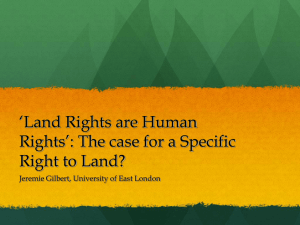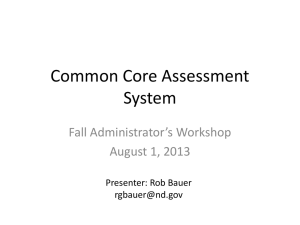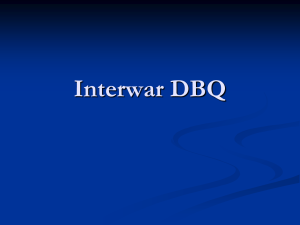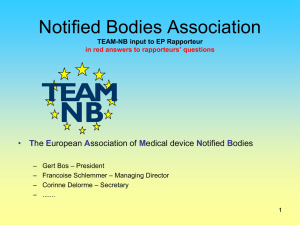Preliminary views
advertisement
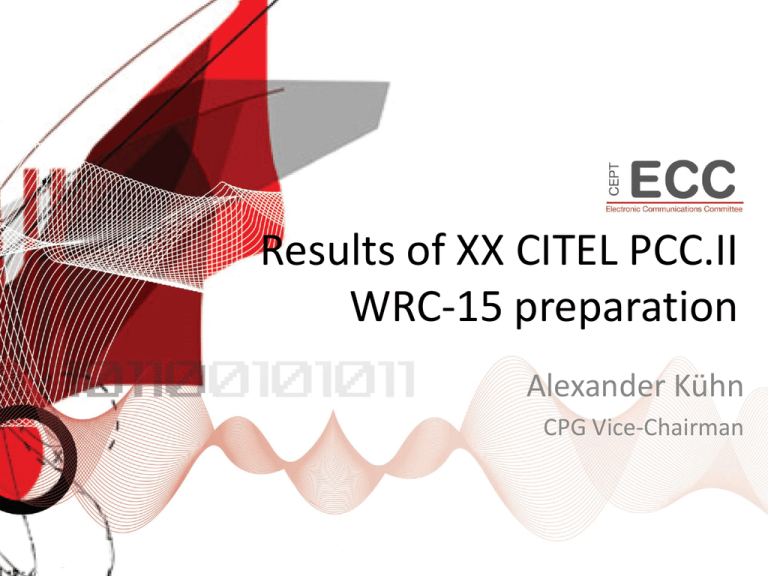
Results of XX CITEL PCC.II WRC-15 preparation Alexander Kühn CPG Vice-Chairman Structure (Doc 3154) • SGT 1 – Mobile and Fixed issues – Coordinator: – Alternate Coordinator: • SGT 2 - Radiolocation, Amateurs, Maritime & Aeronautical – Coordinator: – Alternate Coordinator: • Mr. Tarcisio BAKAUS, BRAZIL (bakaut@anatel.gov.br) Mr. Glenn FELDHAKE, USA (glenn.s.feldhake@nasa.gov) SGT 4 - FSS and satellite regulatory issues – Coordinator: – Alternate Coordinator: • Mr. Jonathan WILLIAMS – USA Mr. Javier GARCIA –DOMINICAN REPUBLIC SGT 3 – Space Science and MSS – Coordinator: – Alternate Coordinator: • Mr. Marco ESCALANTE, GUATEMALA (marco.escalante@ties.itu.int) Mr. José COSTA, CANADA (jose.costa@ericsson.com) Mr. Fernando CARRILLO, MEXICO (carrillo@cft.gob.mx) Mr. Jerry CONNER, USA (jerry.conner@exelisinc.com) Ms. Chantal BEAUMIER, CANADA (chantal.beaumier@ic.gc.ca) SGT 5 – Regulatory – Coordinator: – Alternate Coordinator: Mr. Carmelo RIVERA – USA Mr. Victor VALENCIA –COLUMBIA Agenda item 1.1 • Rapporteur: • Preliminary views: tbd. Agenda item 1.2 • Rapporteur: TBD Alternate Rapporteur : • Preliminary views: Mr. Agostino LINHARES, BRAZIL – CAN [doc.3020] Canada is assessing the studies being conducted in the ITU-R. – USA [doc.3033] The United States is of the view that the studies undertaken by JTG 45-6-7 to address WRC-15 Agenda Items 1.1 and 1.2 are separate and distinct, even if bands of interest to both agenda items prove to be similar. Therefore, sharing and compatibility methodologies that may be utilized in possible sharing and compatibility studies undertaken for WRC-15 Agenda Item 1.2 will not a priori be agreed for application to studies under WRC-15 Agenda Item 1.1. Furthermore, the United States is of the view that there is no basis for any change to the Radio Regulations being addressed under WRC-15 Agenda Item 1.2 that pertain to, or otherwise impact, Region 2. Agenda item 1.3 • Rapporteur: tbd., MEX Alternate: tbd., COL • Preliminary views: – CAN (Doc 3021) is assessing and may contribute to studies on technical and operational issues relating to broadband public protection and disaster relief (PPDR) technology, services and applications including use of commercial and other networks , in accordance with Resolution 648 (WRC-12). Agenda item 1.4 • Rapporteur: tbd. • Preliminary views: – CAN (Doc 3022) May make contributions to ITU-R on sharing, compatibility and other studies conducted under this Agenda item. Agenda item 1.5 • Rapporteur: tbd. • Preliminary views: – CAN (Source 3023/12) Canada will support the use of frequency bands allocated to the fixedsatellite service not subject to Appendices 30, 30A, and 30B for the control and non-payload communications of unmanned aircraft systems (UAS) in non-segregated airspaces only if ITU-R studies show that it is possible to provide safe and efficient integration into the air traffic control system. – USA (Source 3007/12) The United States supports the addition of technical and regulatory provisions that will enable the use of portions of FSS bands for UAS CNPC links in non-segregated airspace, if studies identified in Resolution 153 (WRC-12) demonstrate that the requirements of aviation authorities are satisfied. However, the United States does not support the addition of an AMS(R)S allocation to the bands used by the FSS for this purpose. Agenda item 1.6.1 • Rapporteur: Ms Elisabeth NEASMITH, CAN (eneasmith@telesat.com) • Alternate Rapporteur Agenda Item: • Preliminary views: – Tbd. Agenda item 1.6.2 • Rapporteur: Mr. José Edio GOMES , BRAZIL – Alternate: Ms Elisabeth NEASMITH, CAN (eneasmith@telesat.com) • Preliminary views: – CAN (Doc 3025) Support studies that demonstrate the viability of a new primary allocation to unplanned FSS in the frequency range 13-17 GHz in Regions 2 and 3. Agenda item 1.7 • • Rapporteur: tbd., USA Preliminary views: – CAN (Doc 3026) Any new sharing studies should be limited to new systems of the ARNS as compatibility studies between feeder links of the non-GSO mobile satellite systems in the MSS and the ARNS were already conducted in this band at WRC-07. The primary allocation of the FSS for feeder links of the non-GSO mobile satellite systems in the MSS should be retained in the 5091 – 5150 MHz band without time constraints. – USA (Doc 3036) A permanent primary allocation to the fixed-satellite service for use by feeder links (Earth-tospace) of non-geostationary MSS systems in the 5091-5150 MHz band would be feasible if ITU-R studies show conclusively that the operation of these feeder links are compatible with the operation of ARNS systems in the 5091-5150 MHz band. If no ARNS systems are identified as operating in the band 5091-5150 MHz, the United States supports considering consequential changes to the increase in noise temperature limit from the AM(R)S, while maintaining the overall aggregate interference into the FSS. Agenda item 1.8 • Rapporteur: Ms. Angela MAIMO, USA (angela.maimo@intelsat.com) • Alternate: tbc. • Preliminary views: – CAN (Doc 3027) Supports the modification of Resolution 902 (WRC-03) to more accurately reflect the operations of today’s ESVs and to reduce the coordination burden on administrations. Supports the development of pfd values to replace or supplement coordination distances since these distances depend on the ESVs transmission parameters and are derived from pfd values. • – USA (Doc 3037) Supports the continuation of studies of possible alternative approaches, including the use of a pfd criterion, as a means to allow more flexibility to ESV operation while continuing to protect the other services to which the 5 925 – 6 425 MHz and 14-14.5 GHz bands are allocated. Agenda item 1.9.1 • Rapporteur: tbd. • Preliminary views: – USA (Doc. 3028) If ITU-R studies demonstrate compatibility with incumbent services, the United States will consider supporting allocations to the FSS in the bands 7 150-7 250 MHz and 8 400- 8 500 MHz, or portions thereof, limited to FSS systems operated from a fixed, known location not encompassing small VSAT-like FSS earth stations. Agenda item 1.9.2 • Rapporteur: tbd. • Preliminary views: – CAN, USA (Doc 3006 with revisions) If ITU-R studies demonstrate compatibility with incumbent services, including the adjacent SRS (space-to-Earth) allocation in the band 8 400-8 450 MHz, which is limited to deep space, Canada and the United States will consider supporting allocations to the MMSS in the bands 7 3757 750 MHz and 8 025-8 400 MHz, or portions thereof. ITUR studies should determine appropriate measures (e.g., exclusion zones, radiation limits etc.), that will be needed to ensure protection of existing services in the bands 7375 – 7750 MHz and 8025 - 8400 MHz. Agenda item 1.10 • Rapporteur: [Mr. Don JANSKY, USA (don@jansky-barmat.com)] • Preliminary views: – CAN (Doc 3030/12) Believes that existing MSS allocations at Ka-band are sufficient to accommodate the needs of MSS. [Note: The words “at Ka-band” are in the Spanish version, but not the English version of 3030/12.] Is of the view that sharing with existing allocated services would be difficult. – USA (Doc 3009/12) Supports studies to determine if additional allocations for the MSS in the 2226 GHz frequency range are possible. Before WRC-15 considers any potential allocation to the MSS, the study results must show that MSS is compatible with the incumbent services and does not place undue constraints on those services. Given the propagation characteristics in this frequency range, proponents of the new MSS allocations must provide MSS characteristics demonstrating that the intended services can operate in the 22-26 GHz band with sufficient reliability, and without adversely impacting the planned and current operations of services in the allocations in this frequency range. Agenda item 1.11 • • Rapporteur: Mr. Glenn FELDHAKE, USA (glenn.s.feldhake@nasa.gov) (Alternate: Mr. Muya WACHIRA, CAN (muya.wachira@ic.gc.ca)) • • Preliminary views: CAN Source 3031/12 Supports a new primary allocation for the Earth exploration-satellite service (E-s) to accommodate the TT&C spectrum requirement provided that ITU-R studies show that sharing with existing services is feasible. The studies should focus on the bands around 7.2 GHz, where the sharing scenario is expected to be favourable. Other frequencies in the range 7-8 GHz should be considered only if sharing in the 7.2 GHz band is not feasible. • USA Source 3004/12 Supports a primary allocation to EESS (Earth-to-space) within portions of the 7-8 GHz range with priority to the band 7 190-7 235 MHz, if the studies in accordance with Resolution 650 (WRC-12) prove compatibility with existing services. Supports allocation within other portions of the 7-8 GHz range only if EESS (Earth-to-space) in the 7 190-7 235 MHz band proves insufficient, noting that sharing may be difficult between EESS and existing globally allocated FSS in the 7-8 GHz range. Agenda item 1.12 • • Rapporteur: Mr. Rafael André de LIMA, B (rafaell@anatel.gov.br) (Alternate: tbd.)) • Preliminary views: – USA (Doc 3038) If studies demonstrate that the existing in-band services and the services in the 10.5-10.7 GHz frequency range are protected, the United States supports extending the EESS allocation by up to 600 MHz. Studies should initially consider only the 9 900 MHz – 10.5 GHz range. Only if studies prove that existing services cannot be protected and/or sufficient spectrum cannot be made available in the 9 900 MHz – 10.5 GHz range, does the United States support consideration of the 8 700-9 300 MHz range. – CAN (Doc 3034) Canada supports studies that would lead to the potential extension of the current EESS (active) allocation in the frequency band 9 300-9 900 MHz by up to 600 MHz. Compatibility with existing services will have to be ensured, in accordance with the appropriate protection criteria and taking into account any available mitigation techniques that would reduce the level of unwanted emissions into adjacent band. Agenda item 1.13 • Rapporteur: tbd Alternate Rapporteur : tbd • Preliminary views: – CAN, USA (Doc: 3010/3012) Canada and the United States support the removal of both the 5 km distance limitation and restriction to EVA operation if the studies performed in accordance with Resolution 652 (WRC-12), demonstrate that space vehicle links operating around a manned vehicle beyond 5 km can meet the pfd limits in No. 5.268. Removal of these two restrictions will allow for greater flexibility in using the band 410-420 MHz for space research activities while maintaining protection of the terrestrial services. Agenda item 1.14 • Rapporteur: Mr. Tarcisio BAKAUS, BRA (bakaut@anatel.gov.br) Alternate Rapporteur Muya WACHIRA, CAN (muya.wachira.ic.gc.ca) • Preliminary views: • Option 1: USA (Doc 3005) The United States supports the adoption of UTC without leap seconds as the solution for achieving a continuous reference time-scale for dissemination by radiocommunication systems if the studies, in accordance with Resolution 653 (WRC-12), support this as a viable solution. • Option 2: CAN (Doc 3029) Canada supports ITU-R studies with the aim of finding a compromise solution that would satisfy the need by some administrations to have a continuous reference time-scale while at the same time preserving Coordinated Universal Time (UTC) with its current definition. All options including better implementation and enhanced distribution should be looked at. Canada also believes that clarification of the nomenclature associated with the definition of time in the ITU is required. Agenda item 1.15 • Rapporteur: tbd. Alternate Rapporteur: tbd. • Preliminary views: – CAN (Doc 3044) Studies to determine spectrum requirements and possible technology improvement must be carried out to ascertain any additional spectrum requirements. Agenda item 1.16 • Rapporteur: tbd. Alternate Rapporteur: tbd. • Preliminary views: – CAN (Doc 3045) With additional applications being developed in the maritime mobile service, and taking into account other existing services, Canada supports studies to determine the need for additional spectrum and if required, what frequency band would be appropriate for additional applications using AIS technology. Agenda item 1.17 • Rapporteur Ms. Marcella OST, CAN (marcella.s.ost@boeing.com) Alternate Rapporteur Mr. Luiz Fernando DE SOUZA, BRA lfsouza@embraer.com.br) • Preliminary views: – CAN/USA/B (Doc 3011, 3046) regulatory actions, including appropriate allocations to the AM(R)S limited to WAIC systems within existing worldwide AMS, AMRS and/or ARNS allocations below 15.7 GHz , providing ITU-R studies show compatibility with existing services in accordance with Resolution 423 (WRC-12). Those studies should consider frequency bands above 15.7 GHz only if spectrum requirements cannot be met in existing worldwide AMS, AM(R)S and/or ARNS allocations below 15.7 GHz. Agenda item 1.18 • Rapporteur: tbd. Alternate: tbd. • Preliminary views: – U.S. (Doc. 3012) The United States supports ITU-R sharing, compatibility and regulatory studies between vehicular radars and all services that operate in the 76-81 GHz region of the spectrum. Based on the outcome of those studies, the United States will consider supporting a primary allocation to the radiolocation service in the 77.5-78 GHz band for automotive radars. – CAN (Doc. 3047) Canada will support a primary allocation to the radiolocation service in the frequency band 77.5-78 GHz for automotive short-range high-resolution radars if ITU-R studies show sharing is feasible with existing incumbent services in the band and in the adjacent bands 76-77.5 GHz and 78-81 GHz and fixed service incumbents operating in the bands 71-76 GHz and 81-86 GHz are not impacted upon a positive outcome of the agenda item. Agenda item 2 • Rapporteur: tbd. • Preliminary views: – CAN • Will monitor the development of new and revised ITUR Recommendations and determine whether these should be incorporated by reference in the Radio Regulations, as per Resolution 28. • Will also review references to ITU-R Recommendations with a view to clarifying the status of their reference or remove any ambiguity in their linking language, in accordance with Resolution 27. Agenda item 4 • Rapporteur: tbd. • Preliminary views: – CAN • Will be reviewing the Resolutions and Recommendations of previous conferences, together with the Report from the Director of the BR, in preparation of its proposals to the next CPM and WRC, as appropriate. • Believes that proposals that seek to substantively alter specific resolutions or recommendations, which are not related to another conference agenda item, should not be considered under agenda item 4. Agenda item 7 • • • • Rapporteur : Mr. Juan MASCIOTRA, ARGENTINA (jmasciotra@cnc.gov.ar) Mr. Ramiro ROBLEDO, MEXICO (robledo@cft.gob.mx)) Alternate Rapporteur : Mr. Scott KOTLER, USA (skotler@ntia.doc.gov) Ms. Chantal BEAUMIER, CANADA (chantal.beaumier@ic.gc.ca) Preliminary views: ARG (Doc 3103) The following preliminary considerations should be taken into account in the formulation of positions and InterAmerican Proposals for WRC 15 Agenda item 7: a) b) c) d) e) f) g) h) The advance publication, coordination, notification and recording procedures of satellite radio frequencies assignments of the Radio Regulations should take into account that radio spectrum is a scarce and strategic natural resource requiring equitable distribution among all administrations thereby ensuring the participation of all, especially developing countries, in the exploitation of same for the technological and economic advancement of all. The Radio Regulations should reflect clear, reasonable and accurate timelines for actions required of administrations especially in areas affecting rights of response to the Radiocommunication Bureau requests or the bringing into use of frequency assignments, among other matters. The timelines in the Radio Regulations should be clear and reasonable, reflecting the physical and scientific realities feasible for the construction of satellites that are required to bring into use radio frequency assignments. Clear and reasonable timelines in the Radio Regulations should also, and additionally, reflect and take into account events of force majeure and catastrophic failure that may affect an administration’s otherwise legitimate access to and bringing into use of a radio frequency assignment. When a recorded assignment is being brought into use, either initially or after a period of suspension, it is recognized that efforts differ globally to accomplish this objective and that effort can be additional on the part of developing countries. Mechanisms should be explored to mark this difference in capabilities in a significant way in the advance publication, coordination, recording, and notification procedures of the Radio Regulations. Agenda Item 7 cont´d • • ARG (Doc 3103) i) Without regard to the differing capabilities among administrations, it is recognized that the replacement of a satellite takes a minimum of three years, not taking into account the re-design of same towards potentially different or more advanced technology. j) All administrations, especially those of developing countries share an interest in ensuring timely and accurate receipt of communications from the ITU that may affect rights to use radio frequency assignments. All Radiocommunication Bureau communications that affect an administration´s right to use radio frequency assignments should be delivered securely and by means that reasonably ensure receipt and response. The Radio Regulations should be clear in ensuring that administrations have recourse to respond to significant communication issues that may affect their assignments. k) In matter relating to coordination of frequency assignments, while it is desirable to determine all coordination requirements for a satellite network as early as possible in the coordination process, it is also important to consider whether the current process can be, or needs to be improved to ensure sufficient data is provided to perform an informed interference analysis or respond to the coordination request. l) It is essential to consider the basic principles of Article 44 of ITU Constitution, the Radio Regulations Preamble No. 0.3, and the provisions of Resolution 80 (Rev. WRC-07) to achieve rational, efficient and economic frequency use for radiocommunication services and the associated orbits, including the geostationary-satellite orbit so that countries or groups of countries may have equitable access to said frequencies, taking into account the special needs of the developing countries and the geographical situation of particular countries. While the Radio Regulations currently establish more streamlined procedures for deployment of satellite networks for purely national system coverage, consideration of similar treatment for networks by groups of countries or joint or neighboring administrations for systems including international coverage should be studied. CAN (Doc 3050) – Supports the continued modification, including simplification, of the Radio Regulations procedures that would facilitate their understanding and minimize the need for associated Rules of Procedure. Agenda item 8 • Rapporteur: tbd. • Preliminary views: – CAN Will be reviewing its country footnotes and the inclusion of its country name in existing footnotes to the ITU Table of Frequency Allocations with a view to determining their relevance. Agenda item 9, issue 9.1.4 • Rapporteur: tbd. • Preliminary views: – CAN Will be participating and contributing, where appropriate, in ITU-R studies and within CITEL and will be reviewing the Director’s Report to WRC-15 on this issue in preparation for its proposals to the conference. Agenda item 9, issue 9.1.6 • Rapporteur: tbd. • Preliminary views: – CAN • Will be participating and contributing, as appropriate, in ITU-R studies and within CITEL and will be reviewing the Director’s Report to WRC-15 on this issue in preparation for its proposals to the conference. • Is of the view that this issue needs to be resolved at WRC-15. Agenda item 9, issue 9.1.7 • Rapporteur: tbd. • Preliminary views: – CAN • Recognizes the importance of radiocommunications for use in emergency and disaster relief and will be participating and contributing, as appropriate, in ITU-R studies and within CITEL. • Will also be reviewing the Director’s Report to WRC-15 on this issue in its preparations for the conference. Agenda item 9, issue 9.1.8 • Rapporteur: tbd. • Preliminary views: – CAN • Supports studies to identify the difficulties with the current regulatory framework for nano- and picosatellites. Agenda item 9.2 • Rapporteur: tbd. • Preliminary views: – CAN • Will be participating and contributing, where appropriate, in ITU-R studies and within CITEL and will be reviewing the Director’s Report to WRC-15 in preparation for its proposals to the conference. • Is of the view that the inconsistencies in the application of “Additional allocation” and “Different category of service” in Article 5 should be studied in ITU-R and addressed at WRC-15. Agenda item 10 • Rapporteur: tbd. • Proposal for further work (Doc 3022-10): – In order to facilitate the development of future agenda items for WRC18, Canada proposes to suppress Resolution 808 (WRC-12) as contained in Attachment 1 to this document, and develop a new Resolution [WRC-18 AGENDA] as the basis for the WRC-18 agenda, for consideration by the WRC Working Group of PCC-II. – To facilitate discussions at CITEL and provide a possible means to consolidate and track proposals under Agenda Item 10, the new Resolution [WRC-18 AGENDA], Attachment 2 to this document, is proposed to be carried forward as a working document of SGT-5, whereby administrations may add specific agenda item contributions and/or indicate their support for preliminary proposals, taking into account the “Principles for establishing agendas for world radiocommunication conferences” as detailed in Annex 1 to Resolution 804 (Rev.WRC-12). Also for reference, Resolution 804 (Rev.WRC-12) is contained in Attachment 3 to this document.

